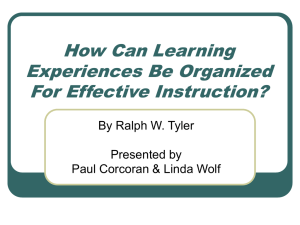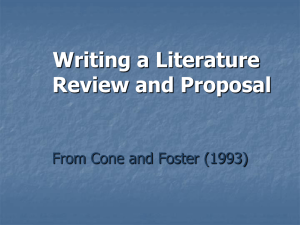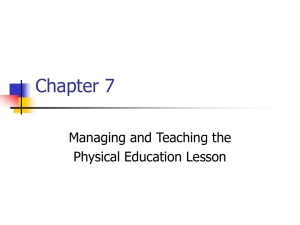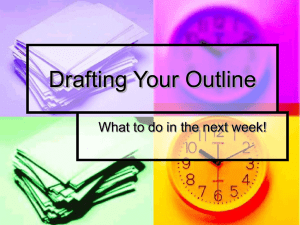- The Art of Getting Over
advertisement
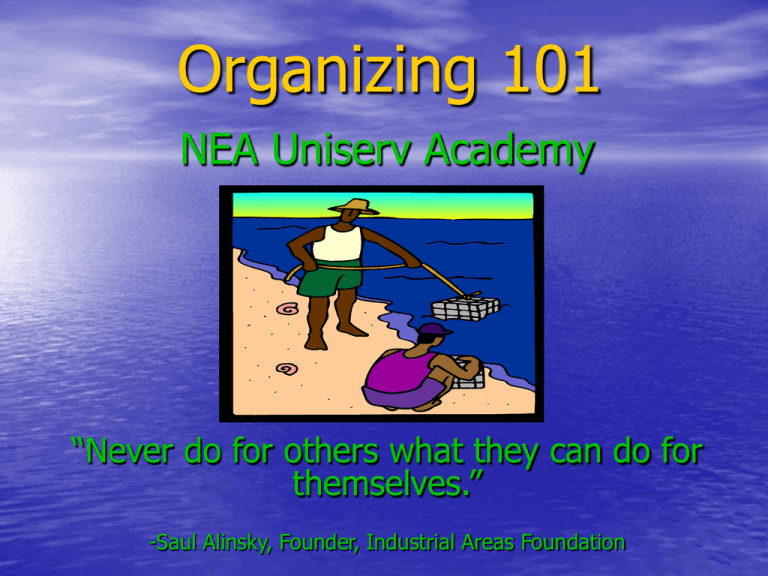
Organizing 101 NEA Uniserv Academy “Never do for others what they can do for themselves.” -Saul Alinsky, Founder, Industrial Areas Foundation What will we be doing today? (With breaks & lunch tucked in!) • • • • • Overview & Introductions What is organizing? Why we organize Types of organize The role of staff in organizing • An effective organizing plan • Organizing principled power Training Objectives • Explore the concept of organizing & its potential • • • • • in building strong locals Define types of organizing Identify characteristics of effective organizers Explore effective organizing plans Internalize the relationship between trust, relational organizing and principled power Practice a key organizing tool – small group discussions What is Organizing? • Celebrity Charades: don’t look & don’t tell; ask up to three yes/no questions per colleague until you ID your celebrity • Form small groups & work on your celebrity’s definition of “organizing” • Prepare, as a group, to share your celebrity’s definition of “organizing” ORGANIZING • A process used to move • • • • • • people to action Creates power Requires systems thinking Appeals to self-interests Develops sustainability Is a science as well as an art Builds organizational capacity Benefits of Organizing Short Term • Job protection • Healthcare • Coalition building • Improved working conditions • Tools for addressing everyday problems Long Term • People learn about themselves • Individuals fully use their skills & abilities • An opportunity to rediscover history struggle & resistance • Relearn cooperation, collective action & support of one another Types of Organizing •Scratch organizing •Revitalization organizing •Issue organizing •Relational organizing Issue Organizing Issue organizing is a strategy that identifies, validates & clearly frames or state the issue by which the members will be motivated. Identification Know the difference between problems & issues. Problems are long-term conditions that give rise to issues. We are concerned about problems. We take on issues. Chronic unemployment is a problem. An announcement of a 50-day layoff is an issue. Validating the Issue When an organizer thinks an issue has been identified, it can be validated with “yes” answers to these questions: • Is it immediate, recent, close at hand? • Is it specific, tangible, clearly understood? • Is it controversial, their position or ours, polarized? • Is it the right size, can we manage it, control it? • Is it winnable, a sure thing? Framing the Issue The organizer creates the organizing theme by stating the issue in such a way that it can be used to 1) focus the constituents’ energies and 2) mobilize people for action. The statement becomes the consistent position of the organizing campaign. Framing is accomplished by combining the following into a statement: Clearly identify the issue Define the issue in such a way that sides are clearly identified Develop & refine the rationale for the issue Problems -vs- Issues PROBLEMS • Global in nature • Create solutions • Long-lasting • Source or cause is distant • Irritating • Encourage study • Resolved only over a long period of time ISSUES • Specific in nature • Emanate from situations • Short-lived • Source or cause is near & identifiable • Inflaming • Encourage action • Resolved over a short period of time Relational Organizing A type of organizing whereby a connection is made to our greater assets & strengths. It focuses on stories, values & beliefs of our members & their self-interests. • Focuses on listening & respecting members’ experiences • • & stories Identifies & recruits leaders Creates & agenda that is driven by the issues, lives & experiences of our members “Organizing is a fancy word for relationship building.” Ernesto Cortes Relational Meeting Concepts • Give & take • The meeting is selective & sensitive • Meetings like this prove an essential human connection that is necessary to build an enduring relationship • Strong sense of self provides basis for taking risks in relationship building • Self-actualization comes from understanding feelings in ourselves & others • You don’t just discuss what people do or their philosophy or their actions. Ultimately, you must get to the level of how people feel about what they do. Relational Meeting Best Practices • • • • • • • • • Work up your curiosity Think about your story Focus on the other person Draw out & share your stories Probe for their interests Ask direct, engaging questions Stick to your time limit Take notes Reflect & evaluate What is listening? Listening is • Receiving information via your eyes & ears • Giving the information meaning • Determining how you feel or what you think about the information • Responding to the information Listening is an intellectual & emotional process that searches for meaning & understanding in a message. Listening Tips • Don’t race up the “ladder of inference” • Monitor & control distractions • Clear your mind of other thoughts • Make direct eye contact • Use supportive voice & body language • Without interrupting or changing the subject, ask clarifying questions “When you are tempted to make a statement, ask a question.” Fred Ross, Sr. The Organizer The duty of the organizer is to provide people with the opportunity to work for what they believe in. A good organizer is a “social arsonist” who goes around setting people on fire! Skills of an Organizer • Ability to ID an issue • Ability to evaluate • • • • human behavior Concern for people Ability to “affirm” others Ability to recognize power Ability to delegate • Ability to determine • • • • needs Ability to navigate tense situations Ability to plan Ability to work from the general to the specific Ability to monitor & evaluate Three Attributes of an Effective Organizer PASSION To have passion you must create a vision of where you want to go PATIENCE Patience requires a commitment to your own vision in the face of “naysayers” PERSEVERANCE To accomplish your vision you must have the courage to persevere Cre8tive” Organizers • Believe that there’s always more than one right answer • Have the ability to look at the ordinary & see the extraordinary • Are not afraid of making mistakes • Reframe problems into opportunities From Everyday Creativity Dewitt Jones “Change means movement. Movement means friction.” Saul Alinsky “Insanity is doing the same thing over and over again, and expecting different results.” In other words . . . “No problem is solved via the same paradigm that created it.” Albert Einstein The Organizing Campaign • WHAT: define the issue/situation • WHY: identify the organizing goals • HOW: define the organizing strategy to employ & the resources that are needed • WHO: determine the leaders & members needed to accomplish the goals • WHEN: organize a sequential timeline of activities & communications that reflect the goals & strategy & that help mobilize the members Specific Organizing Plan Steps • Involve leaders & members from the beginning to ensure • • • • • • • • • • their ownership of & commitment to the plan Define the organizing goal & the desired outcome Identify options for achieving the goal Analyze & prioritize the options Select the best option Plan action steps for achieving the outcome(s) Develop organizing timeline/calendar & budget Develop plan for identification & involvement of members Continually monitor & evaluate the plan, each step, the resources, etc. Continually communicate with leaders & members to ensure Celebrate successes along the way & at the completion of the organizing plan/campaign Keeping the plan on track . . . • Encourage leaders & committee chairs to monitor without micromanaging – model that, too! • Provide feedback to leaders & members, highlighting the accomplishment of key goals, activities, etc., throughout • Offer assistance • If problems are occurring, get involved without taking over the leadership role Take time to Evaluate & Celebrate! • Be sure that members are involved in the evaluation of the organizing efforts • Identify 1) what worked well, 2) what didn’t go so well, 3) what to continue doing, 4) the surprises that occurred, & 5) what materials/records to archive. • Celebrate & publicize the collective & individual contributions & accomplishments, giving credit & thanks to all involved. POWER • The ability or capacity to perform or act effectively • A . . .group . . . having great influence or control over others • Forcefulness • Effectiveness • The capacity of a system . . . to operate The American Heritage Dictionary of the English Language, Fourth Edition, 2000 “Power is the ability to achieve purpose. Whether it is good or bad depends on the purpose.” Martin Luther King, Jr. Types of Power • Coercion / Force • Deception • Blind obedience to authority • Abdication to an “expert” • Informed consent - relational POWER Two Forms • Unilateral • Relational Power over Dominating Control Private Zero sum One way Closed Power with Interactive Mutual Collective Synergistic Quid pro quo Open – public Two Elements of Power Organized PEOPLE Organized MONEY “All power is primarily an illusion . . . Illusion. Mirrors and blue smoke, beautiful blue smoke rolling over the surface of highly polished mirrors, first a thin veil of blue smoke, then a thick cloud that suddenly dissolves into wisps of blue smoke, the mirrors catching it all, bouncing it back and forth.” Jimmy Breslin How the Good Guys Finally Won, Notes from an Impeachment Summer The Yin-Yang of Power B Feelings of Powerlessness Feelings of Powerfulness Dilemmas of Unions Organizational Cultures Service Orientation Single Issue… Confrontational Multi-Issue… Relational Purpose “Help” people Win now Build power over the long term -Involvement Leadership Fixer -Bureaucratic Charismatic mobilizer Collective builders -Accountable Members Viewed as clients Viewed as troops Viewed as story tellers & involved partners Issues Occasional Single Multi-issue Turnout Limited Open Organize then mobilize Activities/Actions Programs & services Events Purpose in mind -- To test organizing & capacity Power Legalistic -- Reliance on others Momentum Relational -- Birthright, redemptive -- Power with On Developing Trust “Anytime a man come into my community and took the hardships that he took, if he was wrong, I better join with him anyway. He’s ready to take a beating, (get) jailed, being bombed and get back on two feet. . . I’m ready to join that fellow, wherever he is, right or wrong.” PERCY LARRY McComb, Mississippi I’ve Got the Light of Freedom by Charles M. Payne Spheres of Influence/Rings of Relationships Self & Self-Interests “Power without love is reckless and abusive . . . and love without power is sentimental and anemic. Power at its best is love implementing the demands of justice.” Martin Luther King, Jr.



